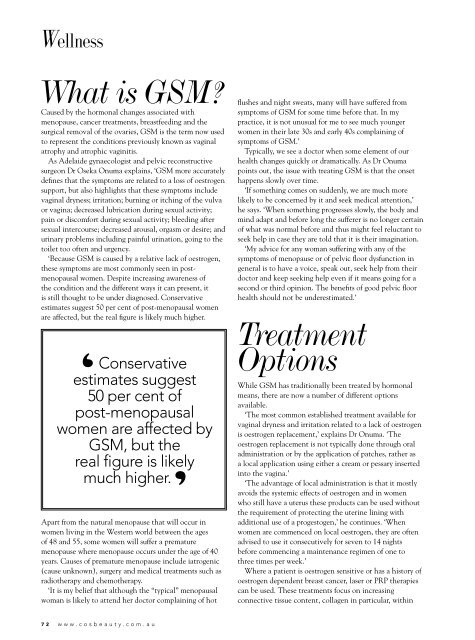CosBeauty Magazine #81
CosBeauty is the #BeautyAddict's guide to lifestyle, health and beauty in Australia. In this issue we look at: • Essential Exfoliation - Smooth Skin for Spring • Why your Beauty Sleep is really important • 40 over 40 - Anti-ageing must have products • Tassie Road Trip • Lauren Hannaford - FHIT for Life • Face Value - Facial Surgeries explained
CosBeauty is the #BeautyAddict's guide to lifestyle, health and beauty in Australia. In this issue we look at:
• Essential Exfoliation - Smooth Skin for Spring
• Why your Beauty Sleep is really important
• 40 over 40 - Anti-ageing must have products
• Tassie Road Trip
• Lauren Hannaford - FHIT for Life
• Face Value - Facial Surgeries explained
You also want an ePaper? Increase the reach of your titles
YUMPU automatically turns print PDFs into web optimized ePapers that Google loves.
Wellness<br />
What is GSM?<br />
Caused by the hormonal changes associated with<br />
menopause, cancer treatments, breastfeeding and the<br />
surgical removal of the ovaries, GSM is the term now used<br />
to represent the conditions previously known as vaginal<br />
atrophy and atrophic vaginitis.<br />
As Adelaide gynaecologist and pelvic reconstructive<br />
surgeon Dr Oseka Onuma explains, ‘GSM more accurately<br />
defines that the symptoms are related to a loss of oestrogen<br />
support, but also highlights that these symptoms include<br />
vaginal dryness; irritation; burning or itching of the vulva<br />
or vagina; decreased lubrication during sexual activity;<br />
pain or discomfort during sexual activity; bleeding after<br />
sexual intercourse; decreased arousal, orgasm or desire; and<br />
urinary problems including painful urination, going to the<br />
toilet too often and urgency.<br />
‘Because GSM is caused by a relative lack of oestrogen,<br />
these symptoms are most commonly seen in postmenopausal<br />
women. Despite increasing awareness of<br />
the condition and the different ways it can present, it<br />
is still thought to be under diagnosed. Conservative<br />
estimates suggest 50 per cent of post-menopausal women<br />
are affected, but the real figure is likely much higher.<br />
‘ Conservative<br />
estimates suggest<br />
50 per cent of<br />
post-menopausal<br />
women are affected by<br />
GSM, but the<br />
real figure is likely<br />
much higher.<br />
’<br />
Apart from the natural menopause that will occur in<br />
women living in the Western world between the ages<br />
of 48 and 55, some women will suffer a premature<br />
menopause where menopause occurs under the age of 40<br />
years. Causes of premature menopause include iatrogenic<br />
(cause unknown), surgery and medical treatments such as<br />
radiotherapy and chemotherapy.<br />
‘It is my belief that although the “typical” menopausal<br />
woman is likely to attend her doctor complaining of hot<br />
flushes and night sweats, many will have suffered from<br />
symptoms of GSM for some time before that. In my<br />
practice, it is not unusual for me to see much younger<br />
women in their late 30s and early 40s complaining of<br />
symptoms of GSM.’<br />
Typically, we see a doctor when some element of our<br />
health changes quickly or dramatically. As Dr Onuma<br />
points out, the issue with treating GSM is that the onset<br />
happens slowly over time.<br />
‘If something comes on suddenly, we are much more<br />
likely to be concerned by it and seek medical attention,’<br />
he says. ‘When something progresses slowly, the body and<br />
mind adapt and before long the sufferer is no longer certain<br />
of what was normal before and thus might feel reluctant to<br />
seek help in case they are told that it is their imagination.<br />
‘My advice for any woman suffering with any of the<br />
symptoms of menopause or of pelvic floor dysfunction in<br />
general is to have a voice, speak out, seek help from their<br />
doctor and keep seeking help even if it means going for a<br />
second or third opinion. The benefits of good pelvic floor<br />
health should not be underestimated.’<br />
Treatment<br />
Options<br />
While GSM has traditionally been treated by hormonal<br />
means, there are now a number of different options<br />
available.<br />
‘The most common established treatment available for<br />
vaginal dryness and irritation related to a lack of oestrogen<br />
is oestrogen replacement,’ explains Dr Onuma. ‘The<br />
oestrogen replacement is not typically done through oral<br />
administration or by the application of patches, rather as<br />
a local application using either a cream or pessary inserted<br />
into the vagina.’<br />
‘The advantage of local administration is that it mostly<br />
avoids the systemic effects of oestrogen and in women<br />
who still have a uterus these products can be used without<br />
the requirement of protecting the uterine lining with<br />
additional use of a progestogen,’ he continues. ‘When<br />
women are commenced on local oestrogen, they are often<br />
advised to use it consecutively for seven to 14 nights<br />
before commencing a maintenance regimen of one to<br />
three times per week.’<br />
Where a patient is oestrogen sensitive or has a history of<br />
oestrogen dependent breast cancer, laser or PRP therapies<br />
can be used. These treatments focus on increasing<br />
connective tissue content, collagen in particular, within<br />
72 www.cosbeauty.com.au

















